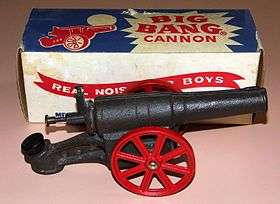Big-Bang Cannon

The Big-Bang Cannon is an American toy cannon first manufactured in the early 20th-century. Numerous consumer fireworks injuries[1] convinced a physics professor at Lehigh University (Bethlehem, Pennsylvania) to patent a "Gas Gun" in 1907, and the manufacturing of Big-Bang Cannons started in 1912, from the Gas Cannon Company.
In 1916, the name was changed to the Toy Cannon Works. In 1924, the company changed names again, to The Conestoga Company, Inc. An assistant professor from the same physics department at Lehigh was the company founder and owner until 1955. The Conestoga Company manufactures nineteen models of Big-Bang Cannon in Allentown, Pennsylvania, Lehigh County.
A bombing plane, tank, boat and pistol were manufactured during the 1920s, firing on the same principle as the cannons. 1930s designs included a Giant Roller Coaster, Ro-To-Top, Spinning Top, Field Glasses and G-Gun.[2]
Repurposed for toymaking, the historic 4-story wood and brick plant is depicted in T. M. Fowler's 1894 "aerial" drawing of West Bethlehem, with ground floor access both from Connestoga St. on the 1st level, and from 1st Ave. at the 4th level. All machinery on the first three levels were driven by a single electric motor via belts and drive shafts the width of the building. In the mid 1950s, the plant burned, and operations were terminated. Dormant several years, the company was bought from physicist & founder Doc Wiley by brothers Frank H. & Robert E. Miller, who rehired Joseph Gombotz as plant manager and future owner. Taken by eminent domain in the late 1960s to construct the 4-lane spur route I-378, the plant moved to E. Goepp St, until its present owners moved it to Sumner Ave. in Allentown. [History in this paragraph provided by Robert E. Miller III.]
Operation
Calcium carbide was one of the first products of electric arc furnaces, made economical by Niagara Falls in 1888. After cooling, irregular chunks were packed in air-tight containers for sale and used to generate acetylene gas by slowing dropping water on them. Small carbide lamps were (and still are) used by miners to produce a very bright flame; larger versions were used on early buses & cars.
These toys operate by introducing a little carbide into a chamber containing some water where it reacts immediately to release acetylene gas. A few seconds later (long enough for the gas to spread out in the chamber, but short enough for it not to be lost out the barrel), it is ignited. A means for introducing fresh air for the next explosion is also provided. Acetylene in air has the widest range of explosive limit of any common chemical[3] and also a very low ignition energy, a combination which very reliably produces a loud “bang” explosion compared to other vapor explosions.
The original 1907 “Gas Gun” patent does not claim novelty for the idea of using carbide-produced acetylene to produce explosions in a toy; rather it was the combination of a gas generator, ignition means, and various parts which were cheap to manufacture. That model used battery-operated spark-coil ignition; widely sold mid-century models created a spark as modern lighters do using ferrocerium.
Another key feature of these devices as toys, is that acetylene explosions, compared to gunpowder, were much safer. The low density of the acetylene/air mixture is such that the total combustion energy is quite low and there is no recoil and little stress on the chamber holding the explosion, even if the outlet barrel was partly blocked. The original toys were brittle cast iron; the company even demonstrated cannons made of glass to show that there was no likelihood of dangerous fracture. Deliberately adding too much carbide does not increase the energy of the explosion but instead weakens it
Since a means for producing a consistent gas charge was important, a special granulated form (about 1 mm grains) of calcium carbide was trademarked as Bangsite in 1952. It could be easily metered in a dispensing mechanism, and promotional materials emphasized that Bangsite was difficult to abuse by hammering, lighting with a match and other things young boys might try.
Patents and trademarks
- "Gas Gun".......patent no. 874,952...patented December 31, 1907
- "Gas Cannon"...patent no. 1,352,715...patented September 14, 1920
- "Toy Firearm"....patent no. 1,624,086...patented April 12, 1927
- "Gas Gun".......patent no. 2,754,607...patented July 17, 1956
- "BIG-BANG"...registered July 31, 1917...reg. no. 117,799
- "BANGSITE"...registered June 10, 1952...reg. no. 559,919
- "CONESTOGA COLLECTORS' SERIES"...registered November 26, 2002...reg. no. 2,653,490
See also
References
Big-Bang Cannons: A Unique American Toy by Raymond V. Brandes, Ray-Vin Publishing Co. ISBN 0-9636127-6-X (Hard Cover)
Blast from the Past: Our History: An American Legend
The Bangster...Volume 1, No. 4, June 1929, published by The Conestoga Corporation
United States Patent and Trademark Office
Toy World Magazine February 1929
- ↑ Brandes, Raymond V. (1993). Big-Bang Cannons: A Unique American Toy. Ray-Vin Publishing. p. 15-19.
- ↑ 1929 Toy World Ad
- ↑ see the explosive limit table
External links
- Official website of Conestoga Company Big-Bang Cannons
- Short YouTube video of a Big-Bang Cannon being fired
- History, safety, and maintenance information for the Big-Bang Cannon from Dave's Cool Toys